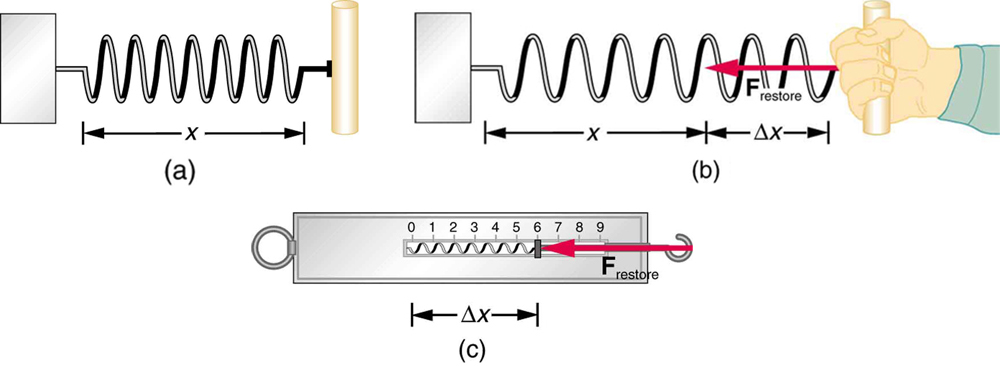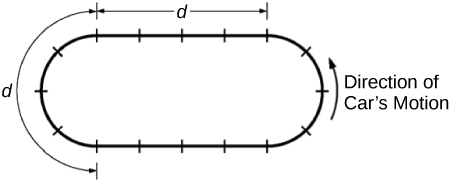| << Chapter < Page | Chapter >> Page > |
A more quantitative definition of force can be based on some standard force, just as distance is measured in units relative to a standard distance. One possibility is to stretch a spring a certain fixed distance, as illustrated in [link] , and use the force it exerts to pull itself back to its relaxed shape—called a restoring force —as a standard. The magnitude of all other forces can be stated as multiples of this standard unit of force. Many other possibilities exist for standard forces. (One that we will encounter in Magnetism is the magnetic force between two wires carrying electric current.) Some alternative definitions of force will be given later in this chapter.

To investigate force standards and cause and effect, get two identical rubber bands. Hang one rubber band vertically on a hook. Find a small household item that could be attached to the rubber band using a paper clip, and use this item as a weight to investigate the stretch of the rubber band. Measure the amount of stretch produced in the rubber band with one, two, and four of these (identical) items suspended from the rubber band. What is the relationship between the number of items and the amount of stretch? How large a stretch would you expect for the same number of items suspended from two rubber bands? What happens to the amount of stretch of the rubber band (with the weights attached) if the weights are also pushed to the side with a pencil?

The figure above represents a racetrack with semicircular sections connected by straight sections. Each section has length d , and markers along the track are spaced d /4 apart. Two people drive cars counterclockwise around the track, as shown. Car X goes around the curves at constant speed v c, increases speed at constant acceleration for half of each straight section to reach a maximum speed of 2 v c, then brakes at constant acceleration for the other half of each straight section to return to speed v c. Car Y also goes around the curves at constant speed v c, increases its speed at constant acceleration for one-fourth of each straight section to reach the same maximum speed 2 v c, stays at that speed for half of each straight section, then brakes at constant acceleration for the remaining fourth of each straight section to return to speed v c.
(a) On the figures below, draw an arrow showing the direction of the net force on each of the cars at the positions noted by the dots. If the net force is zero at any position, label the dot with 0.

The position of the six dots on the Car Y track on the right are as follows:
(b)
i. Indicate which car, if either, completes one trip around the track in less time, and justify your answer qualitatively without using equations.
ii. Justify your answer about which car, if either, completes one trip around the track in less time quantitatively with appropriate equations.

i.
Car X takes longer to accelerate and does not spend any time traveling at top speed. Car Y accelerates over a shorter time and spends time going at top speed. So Car Y must cover the straightaways in a shorter time. Curves take the same time, so Car Y must overall take a shorter time.
ii.
The only difference in the calculations for the time of one segment of linear acceleration is the difference in distances. That shows that Car X takes longer to accelerate. The equation corresponds to Car Y traveling for a time at top speed.
Substituting into the displacement equation in part (b) ii gives . This shows that a car takes less time to reach its maximum speed when it accelerates over a shorter distance. Therefore, Car Y reaches its maximum speed more quickly, and spends more time at its maximum speed than Car X does, as argued in part (b) i.
Which of the following is an example of a body exerting a force on itself?
A hawk accelerates as it glides in the air. Does the force causing the acceleration come from the hawk itself? Explain.
A body cannot exert a force on itself. The hawk may accelerate as a result of several forces. The hawk may accelerate toward Earth as a result of the force due to gravity. The hawk may accelerate as a result of the additional force exerted on it by wind. The hawk may accelerate as a result of orienting its body to create less air resistance, thus increasing the net force forward.
What causes the force that moves a boat forward when someone rows it?
Propose a force standard different from the example of a stretched spring discussed in the text. Your standard must be capable of producing the same force repeatedly.
What properties do forces have that allow us to classify them as vectors?

Notification Switch
Would you like to follow the 'College physics for ap® courses' conversation and receive update notifications?